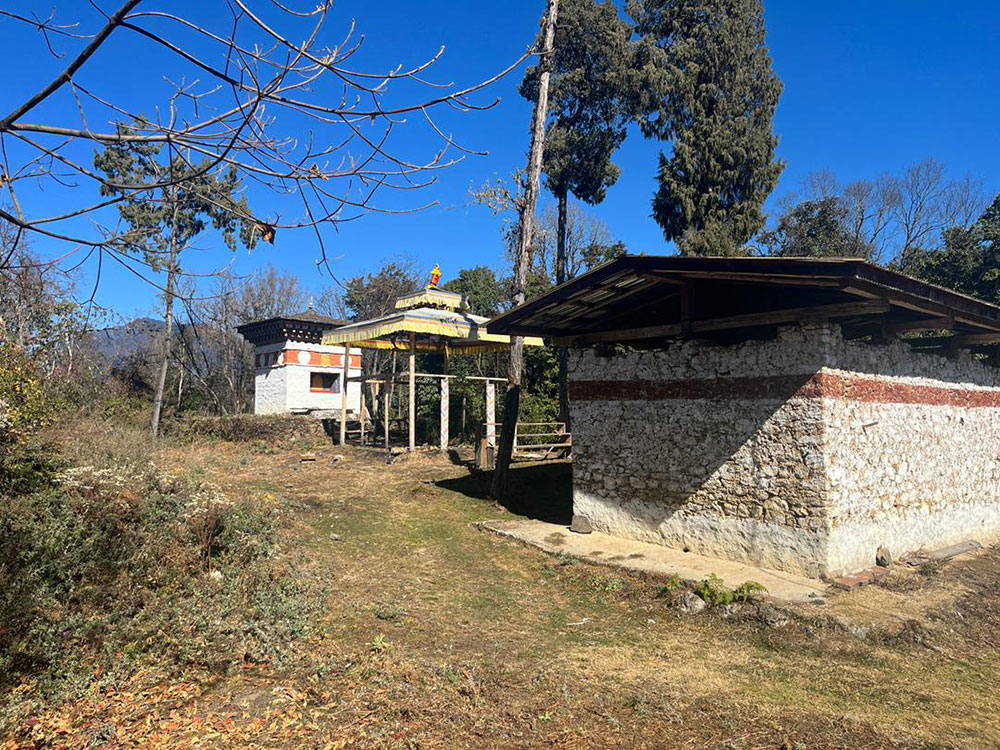Chencho Dema
Punakha — The hallowed Nangsoel Goenpa duethre or crematorium in Goenshari gewog in upper Punakha is in need of urgent renovation, addition of basic amenities, and more monks.
Nangsoel Goenpa Lam Tandin Gyeltshen is concerned that the forest would engulf the crematorium because there was no one to take care of it.
The 40-year-old who was currently overseeing the renovation of the Nangsoel Goenpa a little away from the crematorium ground was also in charge of the crematorium.
“Although the location is far from the district, people do come here and maximum five to six bodies are bought in a year.”
He added that in addition to the infrastructure’s bad state, there were only three monks to support the cremation services, which was not adequate.
According to Tandin Gyeltshen, the crematorium is considered sacred, and unlike other crematoriums, family members are not required to gather the ashes before they can be scattered in the river. That can be left on its own.
The Goenshari gup Wangchuk said although the gewog is well aware about the issue but due to the lack of budget the office could not carry out any works at the crematorium ground.
According to the Lam, in the 14th century, the founder of Barawa Kagyu, Barawa Gyaltshen Pelzang (1310-1391) embarked on a journey to Bodh Gaya in Bihar, India. His mission was to bring a handful of soil from the famous Sitavana charnel ground which is located about 18 kilometers from Bodh Gaya, India.
Je Barawa, as he was popularly known, wanted to replicate the famous charnel ground in Bhutan, specifically at his resident monastery, Nangsoel Goenpa, in present-day Sedchena village, Goenshari Gewog, in upper Punakha.
He performed a rite asking the local deity to grant him some land (Sa-Lhang), and deposited the soil from Sitavana on the lap of a mountain near the monastery. Over the years, the cremation ground attained fame as Duthroe Silwai Tsal in classical Choeked as translated from its original name “Sitavana” in Sanskrit.
However, today the crematorium has fallen into bad times. Apart from a connecting dirt road, a one-room mud-rammed enclosure and an old stupa, there are no other amenities for cremation. The place looks deserted and forlorn amid surrounding forests that have encroached on the little space available.
Its once-vaunted reputation too is on the line. Its fame rested on the belief that the ashes of the dead, after the cremation, would be consumed by Duthroe Dagmo (the deity of the charnel ground), thus there would be no need to gather the ashes as is customarily the practice elsewhere.
Tandin Gyeltshen said the cremation ground is equally sacred like a Sitavana cremation ground; and also, since the Duthro Dagmo (Deity of Cremation Ground) is present here, the ashes of those cremated here disappear naturally and do not have to be cleared.
The local people also say that omens of impending death in the surrounding communities would be foretold through ominous signs at the crematorium. A footprint of a right leg appearing at the crematorium would augur the death of a man and the left leg footprint that of a woman. If death is imminent, the footprint would appear right in the middle of the crematorium.
Sitavana in Maghada in ancient India (presently in Bihar) is the foremost among the eight great charnel grounds of Buddhism in India, according to literature on Buddhism.
Buddhist elders said that it was here that in the 8th century, Guru Padmasambhava practiced for years and attained great spiritual powers with which he tamed numerous malevolent spirits and converted them into Dharma Guardians (Chhoe-Chong.) Sitavana is frequented by Buddhist pilgrims from all over the world to this day.
Je Barawa Gyeltsen Pelzang, meanwhile, was the founder of the Barawa Kagyu, a branch of the Drukpa Kagyu which emerged in the 14th century and spread across Tibet and the Himalayan borderlands, including Bhutan and Sikkim.
Je Barawa was a venerated teacher and religious leader with political influence in Bhutan. His major work, an exegesis on Buddhism, is entitled A Boat by which One Enters Liberation.


